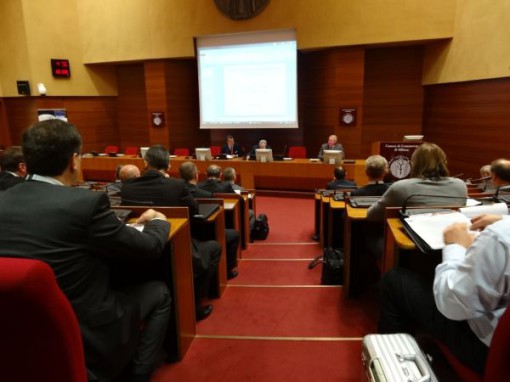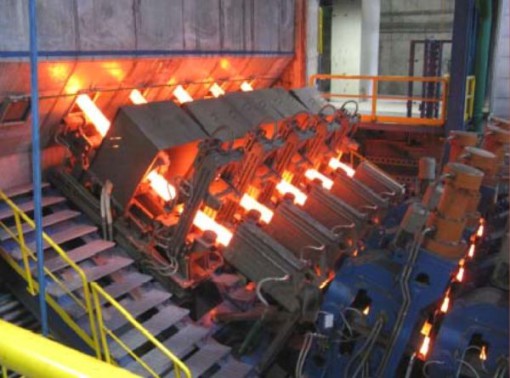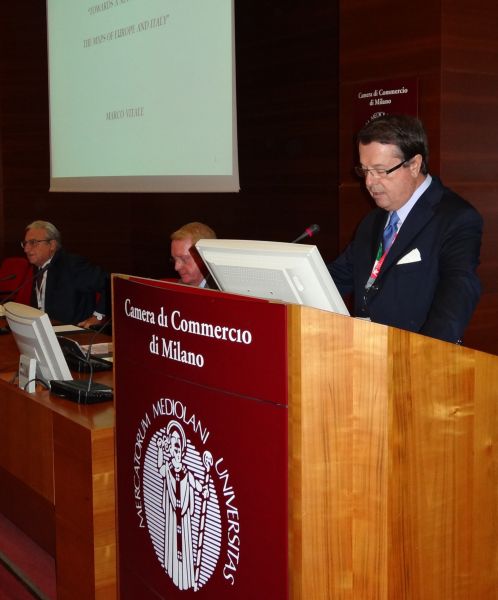Milan, “heart” of the technological updating. Innovation, global competitiveness and cost reduction: these are the main issues discussed during the CabWire Conference held in Milan
It was held last 4th November the sixth edition of CabWire World Conference, the most important world meeting in the sector of ferrous and non-ferrous wires and cables. The event, which in the previous years had been organized in Stresa, Prague, Bologna, Istanbul and Düsseldorf, this time was inspired by the city of Milan, and its venue were the prestigious offices of the Trade Chamber at Palazzo Turati, organized by ACIMAF, the Italian Wire Machinery Manufacturers Association.
The meeting allowed collecting and unitarily analyzing the work of the various international associations (CET, WAI, IWMA, IWCEA, and ACIMAF itself) and of the reference enterprises in the sectors, which delivered technical speeches of absolute relevance at global level and presented the latest innovations.
All the reports were of very high level thanks to the speakers coming from the United States, China, Germany, United Kingdom, Finland, Luxembourg and Italy; they concerned topics of technological character, anyway always regarding the present market context, which has therefore allowed outlining the situation in the wire sector and reasoning about the prospects and that challenges that we should expect in next years. Italy was perfectly represented thanks to the technical speeches by companies of the importance of SAMP S.p.A. Sampsistemi Division, Ori Martin S.p.A., Continuus-Properzi S.p.A., Guidetti S.r.l., Prysmian S.p.A., Mario Frigerio S.p.A., Tecnovo S.r.l. and Koner S.r.l., as well as of Trento University.
The speech by the professor Marco Vitale illustrated the “maps of the new economy” in Italy and in Europe, and of great relevance was also the contribution by Ori Martin steelworks that, besides the technical report about the theme “Wire rod for the future global market”, organized, for the technicians and the experts arrived in Milan from all over the world, a very interesting and exclusive visit to the productive plants in Brescia, very appreciated by all participants for the product quality and the plant efficiency.
We are reporting here, necessarily in brief, all the speeches that followed one another in the course of the CabWire Conference.
Space to “non ferrous”
The programme concerning non ferrous materials, after a first “analysis of the European wire and cable sector” by Philip Radbourne, focused on the issue “Copper scraps: old challenge, present opportunity”, illustrated by Carmelo Maria Brocato of Continuus-Properzi S.p.A. It was a wide-ranging presentation that treated the theme of copper scraps, which can supply a precious raw material for a wide range of wire rods, ingots, billets and plates. In the documents they explained the recycling technologies and the related equipment for the recovery of the various types of copper scraps.
The day went on with the speech by Kazunari Yoshida, Naoyuki Katsuoka and Kota Doi, of Tokai University, in Japan, about the “degradation of mechanical properties of copper drawn wires in presence of dynamic recrystallization“, and the one by Artemio Affaticati of SAMP S.p.A., Sampsistemi Division, on the “main targets and research ambits in a strongly evolving market like the wire and cable one “. The latter speech, in particular, highlighted how the “western” economic crisis and the setback of the Chinese economy compel producers to manufacture equipment with low operating costs, in order to rebalance the investment burden.
Roberto Bentivoglio of Guidetti S.r.l. has thoroughly analysed the question of the “disposal and recovery of electrical cables”, very topical matter of very great interest on a global scale; then, Wolfgang Menne and Horst Scheid, of the German Siebe Egineering, presented a more specific technical issue: “the speed optimization in CV extrusion lines for the insulation of cables with cross-linked PE (PE-Xa)”, while Florian Faul of Maschinenfabrik Niehoff GmbH explained “market and technological dynamics in the sector of the cables for the energy industry”.
Alberto Bareggi illustrated the characteristics of “p-laser”, the new technological platform by Prysmian S.p.A. to implement “extruded medium-voltage cables with insulating materials”, able to confer mechanical and electrical properties resembling or exceeding standard cables’. The study by Jorma Leppanen, Pekka Huotari and Eero Korolainen of the Finnish companies Maillefer Extrusione Oy and Neutro Oy, instead treated “the reduction of costs and the efficiency improvement in the production of medium-voltage cables with CV lines“.
The “non-ferrous programme” went on with a survey of the most important applications of the “wound cable” technology illustrated by Gerhard Boockmann, Michaela Boockmann and Kai Boockmann of the German Boockmann GmbH and ended with the report by Stuart Duff, of the British Kuwait Petroleum International Lubricants, about the theme “how to enhance the performances of the aluminium drawing process by means of emulsion”.
The “ferrous” to the rescue
Concerning the “ferrous programme”, besides the already mentioned “Wire rod for the future global market”, speech by Alberto Franchi, Fabio Guarneri, Alessandro Lombardi and Vincenzo Volponi of Ori Martin Group, very specific topics were discussed. Emmanuel De Moor and Stephanie L. Miller of Colorado School of Mines, United States, illustrated for instance “the effects of the addition of niobium and vanadium in micro-alloyed steel wires with high carbon content; Rüdiger Lux, Ulf Kletzin, Veronika Geinitz and Peter Beyer of Ilmenau University of Technology, Germany, explained “the changes of the mechanical parameters in cold-drawn steel wires with a patented conservation process”; René Branders of FIB Belgium SA (Belgium) thoroughly analysed the subject of “energy saving in automated annealing and austenitizing processes with open furnace”, while Mark Hayes of the Institute of Spring Technology (UK) examined “the effects of the heat treatment on the properties of tension springs”.
Lively interest aroused the study by Tecnovo S.r.l., Koner S.r.l. and of Trento University through the speeches by Giancarlo Arrighetti, Fabio Bellina, Enrico Bisoffi and Giovanni Garoli, who treated the theme: “the use of titanium dioxide in lubricants for dry drawing”. Since the titanium dioxide is “under observation” in several Countries owing to the presumed risks for the operators’ health, and we expect that its use will be strongly limited, or even completely forbidden, in the next years, the speech illustrated a new line of lubricants for drawing completely free from that component, able to improve the lubrication and the resistance to wear and to increase the recycling and reuse possibilities of the carbide.
Another “made in Italy” report was delivered by Alberto Visconti of Mario Frigerio S.p.A. (MFL Group), who discussed the most recent demands of the market in the sector of “high strength cables” and on the consequent need of revising the drawing programmes and of producing machines able to cool the generated heat.
Highly appreciated was also the speech by Marcus Paech of Witels-Albert GmbH (Germany) and Walther Van Raemdonck of Bekaert N.V. (Belgium) about the “online diagnosis of the wire quality”, innovative method developed to monitor some important characteristics of the wire, like resistance and diameter, during the drawing process.
The “ferrous programme” ended with the speeches by Peter Janßen about the new production plant of wire rods of ArcelorMittal in Duisburg (Germany), and by Philippe van Bogaert of Bogimac Engineering NV (Belgium) about the methods and equipment to test the behaviour of wires, cables, ropes, belts etc, under “similar” conditions to the operating ones.
The China problem
All the associations and the guests appreciated the efforts lavished by ACIMAF to organize CabWire World Conference, also for the dinner held after the convention in the ancient and elegant rooms of Palazzo Clerici in Milan, where the Tiepolo frescoes were the precious frame. «The appreciation of our guests – underlined Ferruccio Bellina, president of ACIMAF – was very positive. It was an event that gave prestige and lustre to our Country and to our companies that, in spite of all, continue to export quality and excellence worldwide ».
Among the, the steelworks Ori Martin, which opened the doors to foreign visitors: «It was a really special visit; the managers of Brescia Group demonstrated that, in the ambit of the wire rod, Italy still has a say, even if we European are increasingly “delocalizing” the steel production abroad ».
The remark allows us to ask other questions of general character to the president Bellina. One of the most interesting concerns the health state of Italian enterprises’ competitiveness. «Our companies – notices the president of ACIMAF – have reached the highest levels and for long time we have been competing with German enterprises on equal terms. We are undoubtedly market leader in some particular sectors. The real danger for our competitiveness comes from Countries like China, where in the last 10 years industry made great strides, and soon it will come from India, too. Sorry to say that, but several Chinese enterprises have copied our machines in shameless way, to say the least, proposing them at very low prices, not only for their home market but also for the extra-Asian one. Nowadays Chinese machines are bought also by us, in Europe, and this is a really worrying phenomenon».
Besides, the last economic data indicate that in China a neat decrease of the home demand is taking place. «Exactly. And it is just for this reason that Chinese tend to be even more aggressive with exports. They can rely on enormous facilitations, privileges and very low taxes. Unlike what happens here, the “Chinese system” favours export, and for this reason, let me use this expression, today “we find Chinese products everywhere”, since they can be sold at unrealistic prices for us, European. Moreover, as already said, several Chinese enterprises shamelessly copy our machines ».
Is there no way to protect the intellectual property in these cases? «Warranties are almost null. Italian enterprises are almost firms that export over 90% of their production, therefore they should bear “protection costs of the intellectual property” in each Country where they sell machines, with an overall expense in the order of dozen million Euros. It is an unbearable expense for small-medium size companies like those operating in the wire and cable industry. Besides, protecting a mechanical product is even more difficult than protecting a brand, a gastronomic product or a fashion garment ».
How, then, can Italian enterprises react to that situation? «There is no other answer than to try to innovate, implementing machinery and complex, special, new manufactured goods, betting on the quality of mechanics, on the electronic efficiency, on the energy saving and so on. We should remain always a step ahead, unlike those that, on the contrary, prefer copying …».
And do you think that are Italian and European enterprises, in general, a cut above, from the innovation and quality point of view, in comparison with Chinese ones? «Yes, certainly. Some Chinese machines are so scarcely technological that they are considered “disposable”: they cost little, it is true, but what is the use of such machines? Unfortunately, it is also true that the global crisis is displacing the “centre of gravity of the demand”. Today, the new machines are requested just by the so called rising Countries, whose users have not the same competences as ours, and then they look more at the price than at performances. It is an enormous limitation for us, producers: the “price war” is a very strong hindrance to the development, also because, in those terms, the battle would be lost at the start. In other words, we should try to bet still on quality and to assert our technological culture, and to try to have our products sold all over the world, in rising Countries, too ».
Are you hopeful for the future? «Yes, certainly. The hope is that the global economic situation can change, that the market has new life and that companies invest again in high quality products. We must add that, finally, also in rising Countries like China, the labour cost is growing and that, sooner or later, they too will be compelled to give in on the front of non-protectionism, pollution, safety and protection of workers, of the environmental impact etc.






